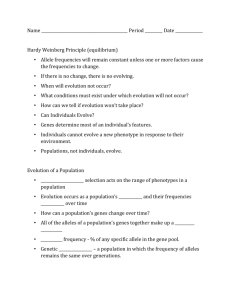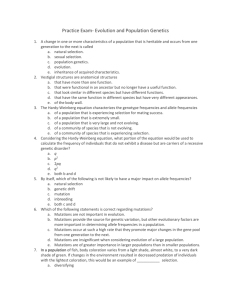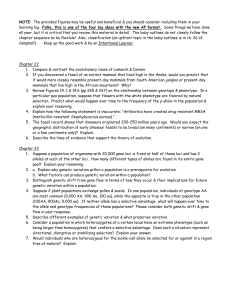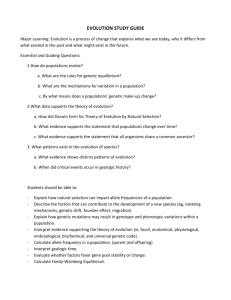Chapter 18: Evolutionary Change in Populations
advertisement
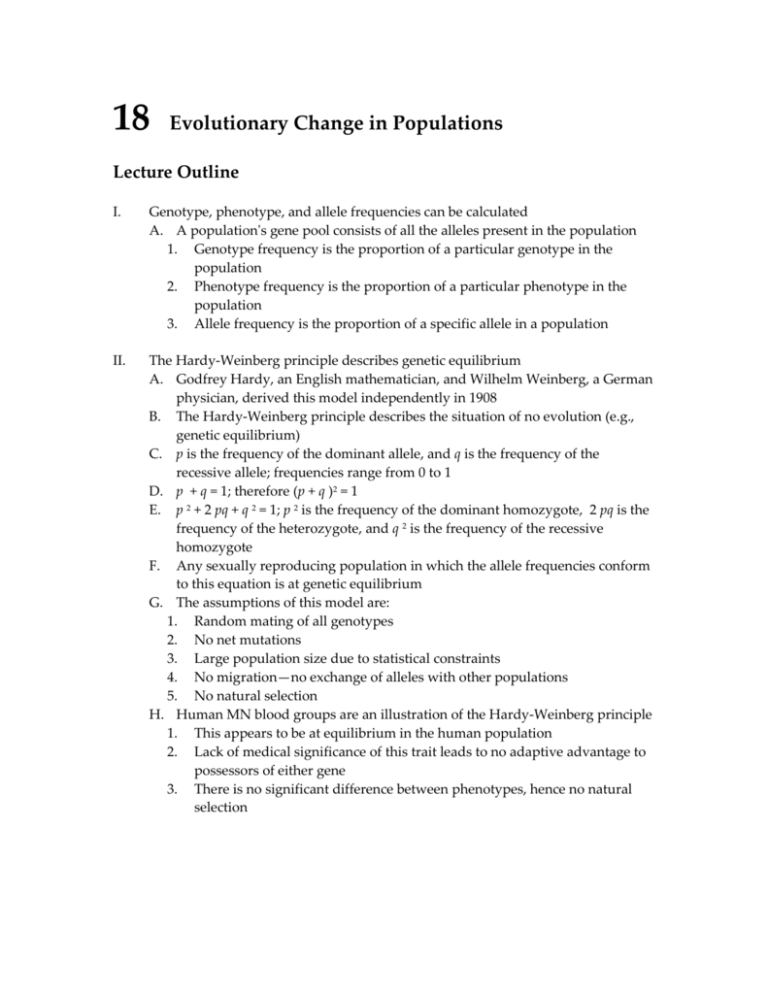
18 Evolutionary Change in Populations Lecture Outline I. Genotype, phenotype, and allele frequencies can be calculated A. A population's gene pool consists of all the alleles present in the population 1. Genotype frequency is the proportion of a particular genotype in the population 2. Phenotype frequency is the proportion of a particular phenotype in the population 3. Allele frequency is the proportion of a specific allele in a population II. The Hardy-Weinberg principle describes genetic equilibrium A. Godfrey Hardy, an English mathematician, and Wilhelm Weinberg, a German physician, derived this model independently in 1908 B. The Hardy-Weinberg principle describes the situation of no evolution (e.g., genetic equilibrium) C. p is the frequency of the dominant allele, and q is the frequency of the recessive allele; frequencies range from 0 to 1 D. p + q = 1; therefore (p + q )2 = 1 E. p 2 + 2 pq + q 2 = 1; p 2 is the frequency of the dominant homozygote, 2 pq is the frequency of the heterozygote, and q 2 is the frequency of the recessive homozygote F. Any sexually reproducing population in which the allele frequencies conform to this equation is at genetic equilibrium G. The assumptions of this model are: 1. Random mating of all genotypes 2. No net mutations 3. Large population size due to statistical constraints 4. No migration—no exchange of alleles with other populations 5. No natural selection H. Human MN blood groups are an illustration of the Hardy-Weinberg principle 1. This appears to be at equilibrium in the human population 2. Lack of medical significance of this trait leads to no adaptive advantage to possessors of either gene 3. There is no significant difference between phenotypes, hence no natural selection III. Microevolution occurs when a population’s allele or genotype frequencies change A. Evolution occurs when a population does not meet all of the assumptions of the Hardy-Weinberg principle B. These small changes are referred to as microevolution IV. Nonrandom mating changes genotype frequencies A. When individuals reproduce with individuals of similar genotypes by choice or location, deviations from equilibrium occur 1. This may lead to inbreeding, which may lead to increased homozygosity 2. This may lead to inbreeding depression and lowered fitness in the population, common in some plants B. Assorattive mating occurs when mating is influenced by similar phenotypes 1. Positive assortative mating also increases homozygosity 2. Humans exhibit positive assortative mating in many cases V. Mutation increases variation within a population A. Mutations provide the raw material for evolution as it introduces variation B. Mutations are unpredictable, permanent changes in the DNA C. Mutations in somatic cells are not heritable D. Mutations are not directed E. Mutations cause small deviations from Hardy-Weinberg equilibrium VI. In genetic drift, random events change allele frequencies A. Small populations are more prone to lose alleles present at low frequencies B. Random changes in allele frequencies in small populations is referred to as genetic drift 1. Genetic drift tends to eliminate alleles, whether they are harmful or favorable 2. Genetic drift tends to decrease genetic variation within a population C. When bottlenecks occur, genetic drift becomes a major evolutionary force 1. Genetic bottlenecks are rapid and severe declines in the number of individuals in the population, followed by an increase in different allele frequencies 2. After the bottleneck, the allelic frequencies in the population may be markedly different than before the decline a) Cheetahs have experienced two genetic bottlenecks that severely decreased their genetic variability D. The founder effect occurs when a few "founders" establish a new colony 1. This type of genetic drift occurs when a small fraction of a population establishes a new colony 2. Founder effect is common in island populations a) The Finnish population exhibits much less allelic variation than the general European population b) A well-studied Amish population in Pennsylvania those this in an increase in numbers of people with an allele for a form of dwarfism VII. Gene flow generally increases the amount of variation in a population A. Migration of breeding individuals introduces new allelic frequencies to a population B. Gene flow tends to counteract both natural selection and genetic drift, as it causes populations to become more genetically similar C. Within the past few hundred years, humans have experienced an increase in gene flow VIII. Natural selection changes allele frequencies in a way that increases adaptation A. Natural selection is based on differential reproduction B. Natural selection operates on an organism's phenotype C. Natural selection acts on the phenotype, which is an expression of the genotype 1. Characters that are polygenic exhibit a range of phenotypes in a population D. Stabilizing selection favors intermediate phenotypes 1. A classic example is human birth weight 2. Stabilizing selection results in reduced variation in a population E. Directional selection favors one phenotype over another 1. Directional selection favors one extreme of the normal distribution over the other phenotypes 2. The Galapagos finches are an example of directional selection by diversification into many different species F. Disruptive selection favors phenotypic extremes 1. Disruptive selection selects for 2 or more different phenotypes 2. This may result in splitting of a population into 2 or more separate species IX. Genetic variation is necessary for natural selection A. Variation is a result of mutation as well as crossing over, independent assortment, and random fertilization of the eggs by sperm B. Genetic polymorphism exists among alleles and the proteins for which they code 1. Genetic polymorphism may be estimated by comparing proteins using gel electrophoresis 2. Polymorphism may be directly measured by determining DNA sequences C. Balanced polymorphism can exist for long periods of time 1. Genetic variation may be maintained by heterozygote advantage a) An example of heterozygote advantage is the malarial resistance in carriers of the sickle cell allele b) Carriers produce both normal and abnormal hemoglobin, and the malarial parasite is not able to invade the red blood cells 2. Genetic variation may be maintained by frequency-dependent selection a) Some phenotypes may be more advantageous if they are rare b) Prey with uncommon characteristics may be ignored by predators D. Neutral variation may give no selective advantage or disadvantage 1. Random mutations in the DNA that do not alter protein structure do not alter the phenotype 2. Neutral variations in one environment may be helpful or harmful in a different environment E. Populations in different geographical areas often exhibit genetic variation 1. A cline is the variation in genotype and phenotype within 1 species over a geographic range 2. Examination of the body size, for example, of a mammalian species over its range varies, typically with larger animals found at higher altitudes and latitudes Research and Discussion Topics Other examples of heterozygote advantage include cystic fibrosis and cholera, and tuberculosis and Tay Sachs disease. Research these conditions and describe the cause for the relative high frequency of these genes, which may cause serious disease conditions or death to homozygous recessives. Think about how the bottleneck effect applies to the captive breeding programs of zoos and animal parks. Do you think it makes sense to try to "resuscitate" a species based on just a handful of individuals? What would you recommend as a comprehensive plan, if you were the director of a zoo and were in charge of 25 primates, the last known members of their species, which reside in your zoo. What breeding plan might you devise?


